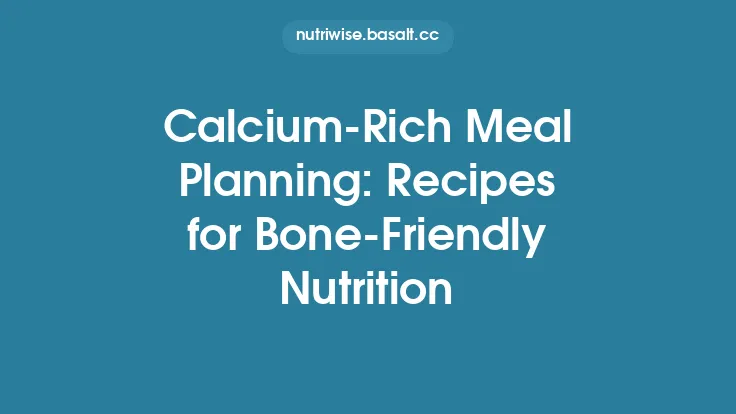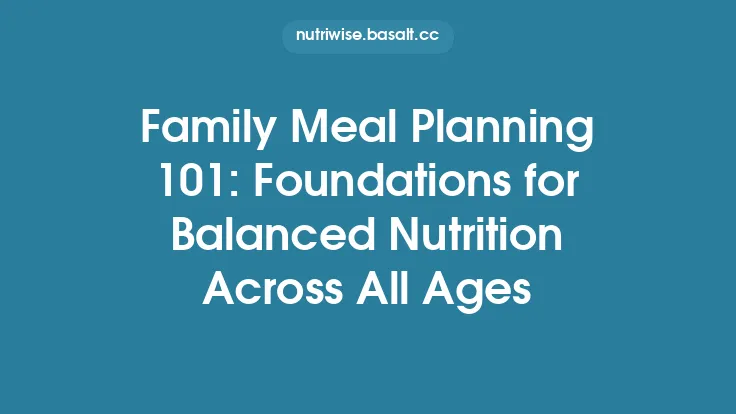A heart‑healthy diet isn’t just about swapping one ingredient for another; it’s a systematic approach to building meals that consistently deliver the nutrients your cardiovascular system needs while keeping dietary cholesterol low. By treating meal planning as a structured, repeatable process, you can create menus that are both nutritionally robust and enjoyable, reducing the mental load of daily decision‑making and supporting long‑term heart health.
Understanding the Foundations of a Heart‑Healthy Menu
Before you start arranging dishes on a plate, it helps to grasp the physiological rationale behind each food group’s role in cardiovascular health.
| Nutrient | Primary Cardiac Benefit | Typical Low‑Cholesterol Sources |
|---|---|---|
| Soluble Fiber | Binds bile acids, helping the liver remove excess cholesterol from the bloodstream. | Oats, barley, legumes, apples, carrots |
| Plant‑Based Protein | Provides essential amino acids without the saturated fat found in many animal proteins. | Lentils, chickpeas, tofu, tempeh, edamame |
| Monounsaturated & Polyunsaturated Fats (in moderation) | Improves lipid profiles by lowering LDL‑C and raising HDL‑C. | Avocado, nuts, seeds, certain vegetable oils |
| Potassium‑Rich Foods | Counteracts sodium‑induced blood‑pressure elevation. | Bananas, sweet potatoes, spinach, white beans |
| Antioxidants (e.g., flavonoids, carotenoids) | Reduce oxidative stress and inflammation, key drivers of atherosclerosis. | Berries, citrus, leafy greens, red peppers |
Understanding these relationships lets you prioritize foods that actively support heart function rather than merely avoiding “bad” items.
Assessing Your Nutritional Needs and Goals
Every individual’s caloric and macronutrient requirements differ based on age, sex, activity level, and existing health conditions. A practical first step is to calculate your estimated energy requirement (EER) using the Mifflin‑St Jeor equation, then adjust for activity:
- Men: EER = 10 × weight (kg) + 6.25 × height (cm) – 5 × age + 5
- Women: EER = 10 × weight (kg) + 6.25 × height (cm) – 5 × age – 161
From the total calories, allocate macronutrients with a heart‑focused lens:
- Protein: 15‑20 % of total calories (≈0.8‑1.0 g/kg body weight) – emphasize plant‑based sources.
- Fat: 25‑30 % of total calories – prioritize unsaturated fats, keep saturated fat <7 % of total calories.
- Carbohydrate: 50‑55 % of total calories – focus on high‑fiber, low‑glycemic options.
If you have specific lipid targets (e.g., LDL‑C < 100 mg/dL), you may further refine these ratios in consultation with a healthcare professional.
Choosing Low‑Cholesterol Protein Sources
Dietary cholesterol is primarily found in animal products. While modest consumption isn’t inherently harmful, reducing overall intake simplifies lipid management. Below are categories and practical tips for integrating low‑cholesterol proteins:
| Category | Representative Foods | Preparation Tips |
|---|---|---|
| Legumes | Black beans, split peas, lentils | Cook in bulk, season with aromatics, freeze in portioned bags. |
| Soy Products | Firm tofu, tempeh, soy milk (unsweetened) | Press tofu to remove excess water, marinate for flavor, crumble tempeh for “ground meat” texture. |
| White‑Fish & Shellfish | Cod, pollock, shrimp | Steam, poach, or bake with citrus and herbs; avoid breading. |
| Low‑Fat Dairy | Skim milk, low‑fat Greek yogurt, cottage cheese (≤2 % fat) | Use as a base for sauces, dressings, or protein‑rich snacks. |
| Egg Whites | Fresh or liquid egg whites | Incorporate into omelets, frittatas, or baked goods for protein without yolk cholesterol. |
When animal protein is desired, opt for lean cuts (e.g., skinless poultry breast) and limit portion size to 3‑4 oz (≈85‑115 g) per serving.
Incorporating Fiber‑Rich Carbohydrates
Fiber serves a dual purpose: it moderates post‑prandial glucose spikes and assists in cholesterol excretion. Two fiber types are especially heart‑friendly:
- Soluble Fiber – forms a gel in the gut, binding bile acids. Aim for 5‑10 g per day from sources like oats, barley, and legumes.
- Insoluble Fiber – adds bulk, promoting regular bowel movements. Include whole‑grain breads, brown rice, and starchy vegetables.
Practical integration:
- Replace refined grains with whole‑grain alternatives (e.g., quinoa, farro, bulgur) in salads and side dishes.
- Add a ½‑cup of beans to soups, stews, or grain bowls for an extra fiber boost.
- Use vegetable purees (e.g., cauliflower mash) as a lower‑calorie, fiber‑dense substitute for starchy sides.
Strategic Use of Healthy Fats (Without Overemphasis)
While the article’s focus isn’t on fats per se, a balanced menu must include modest amounts of unsaturated fats to aid nutrient absorption and improve lipid profiles. Keep the following guidelines in mind:
- Portion control: One tablespoon of oil (≈14 g) provides ~120 kcal; use measuring spoons or a spray bottle to avoid excess.
- Distribution: Add a small amount of fat at each main meal (e.g., a drizzle of olive oil on roasted vegetables) rather than loading a single dish.
- Food pairing: Combine fat with fat‑soluble vitamins (A, D, E, K) found in leafy greens and carrots to maximize bioavailability.
Designing Balanced Meals Across the Day
A well‑structured day typically includes three main meals and one to two snacks. The “plate method” can be adapted for heart‑healthy planning:
- Half the plate: Non‑starchy vegetables (raw, steamed, roasted).
- Quarter of the plate: Lean protein or plant‑based protein.
- Quarter of the plate: Whole‑grain or starchy vegetable source.
- Side: A modest portion of healthy fat (e.g., ¼ avocado, a handful of nuts).
Sample Day
| Meal | Components | Approx. Nutrient Breakdown |
|---|---|---|
| Breakfast | Greek yogurt (low‑fat) + mixed berries + 2 Tbsp chia seeds + ¼ cup rolled oats | 20 g protein, 8 g fiber, 12 g fat (mostly polyunsaturated) |
| Mid‑Morning Snack | Apple slices + 1 Tbsp almond butter | 4 g protein, 5 g fiber, 9 g fat |
| Lunch | Quinoa salad with black beans, diced bell pepper, spinach, lemon‑olive‑oil dressing | 18 g protein, 10 g fiber, 7 g fat |
| Afternoon Snack | Carrot sticks + hummus (2 Tbsp) | 3 g protein, 4 g fiber, 5 g fat |
| Dinner | Baked cod (4 oz) + roasted sweet potatoes (½ cup) + steamed broccoli + drizzle of walnut oil | 25 g protein, 7 g fiber, 8 g fat |
By visualizing each meal’s composition, you ensure consistent nutrient delivery without the need for daily calculations.
Creating a Weekly Meal Blueprint
A weekly blueprint reduces decision fatigue and streamlines grocery trips. Follow these steps:
- Select a Core Protein Set – Choose 3‑4 low‑cholesterol proteins (e.g., lentils, tofu, cod, low‑fat turkey).
- Pick Complementary Carbohydrate Bases – Identify 2‑3 whole‑grain or starchy vegetables (e.g., brown rice, quinoa, sweet potatoes).
- Assign Vegetable Themes – Rotate between leafy greens, cruciferous veg, and colorful peppers to maximize micronutrient variety.
- Map Meals – Use a simple table (Monday‑Sunday) to assign a protein–carb–veg combo to each dinner, then repurpose leftovers for lunch.
- Plan Snacks – List 5‑7 portable options (e.g., fruit‑nut combos, yogurt cups, roasted chickpeas) that can be grabbed on the go.
Example Blueprint (Dinner Focus)
| Day | Protein | Carb | Veg | Flavor Profile |
|---|---|---|---|---|
| Mon | Lentil stew | Brown rice | Kale & carrots | Mediterranean (olive oil, oregano) |
| Tue | Baked cod | Quinoa | Roasted Brussels sprouts | Lemon‑herb |
| Wed | Tofu stir‑fry | Whole‑grain noodles | Snow peas & bell pepper | Asian‑ginger |
| Thu | Turkey meatballs (lean) | Sweet potato mash | Steamed green beans | Italian (basil, garlic) |
| Fri | Chickpea curry | Bulgur | Spinach | Indian (turmeric, cumin) |
| Sat | Egg‑white frittata | Whole‑grain toast | Mixed salad | Classic |
| Sun | Grilled salmon (optional for occasional higher‑fat fish) | Barley pilaf | Asparagus | Herb‑butter (light) |
The blueprint can be printed or saved digitally, allowing quick reference during the week.
Smart Grocery Shopping for Heart‑Friendly Ingredients
A strategic shopping list is the backbone of successful meal planning. Consider these tactics:
- Organize by Store Section – Group items into produce, pantry, dairy, and frozen categories to minimize back‑and‑forth trips.
- Prioritize Whole Foods – Choose whole fruits, vegetables, and bulk legumes over pre‑packaged, processed alternatives.
- Read Labels for Hidden Cholesterol – While animal‑derived foods are the main source, some processed items (e.g., certain baked goods) may contain egg yolk or dairy powders. Look for “cholesterol 0 mg” or “cholesterol‑free” claims.
- Select Low‑Sodium, Low‑Sugar Variants – Even though sodium isn’t the primary focus, choosing products with modest sodium levels supports overall cardiovascular health.
- Buy in Seasonal Bulk – Even though a separate article covers seasonal produce, purchasing in bulk when prices are low reduces waste and ensures a steady supply of heart‑healthy staples.
Pantry Staples and Stocking Strategies
A well‑stocked pantry eliminates the need for last‑minute, less‑healthy choices. Keep the following categories on hand:
| Category | Examples | Storage Tips |
|---|---|---|
| Legumes (dry or canned, low‑sodium) | Black beans, lentils, chickpeas | Store dry beans in airtight containers; rotate canned goods using FIFO. |
| Whole Grains | Quinoa, farro, rolled oats, brown rice | Keep in cool, dark place; consider vacuum‑sealing for longevity. |
| Nuts & Seeds | Walnuts, almonds, chia, flaxseed (ground) | Store in the refrigerator to prevent rancidity. |
| Healthy Oils | Extra‑virgin olive oil, avocado oil (small bottle) | Keep away from heat and light; use a spray bottle for portion control. |
| Flavor Foundations | Low‑sodium broth, canned tomatoes (no added sugar), vinegar, mustard | Use these to build depth without relying on high‑fat sauces. |
| Frozen Vegetables & Fruits | Mixed berries, edamame, spinach | Ideal for quick meals; retain nutrients when flash‑frozen. |
Periodically audit your pantry to discard expired items and replenish only what aligns with your weekly blueprint.
Batch Cooking and Meal Prep Techniques
Batch cooking saves time and ensures consistency in nutrient intake. Follow a systematic approach:
- Choose a “Prep Day” – Typically Sunday or a weekday evening.
- Cook Core Components in Bulk
- Legumes: Simmer a large pot of mixed beans; portion into containers.
- Grains: Cook a double batch of quinoa and brown rice; cool and store.
- Proteins: Roast a sheet pan of tofu cubes and cod fillets with minimal oil.
- Pre‑Portion Vegetables
- Wash, trim, and store leafy greens in breathable bags.
- Roast a mix of root vegetables (sweet potatoes, carrots) for quick reheating.
- Assemble Ready‑to‑Eat Meals
- Layer grain, protein, and veg in meal‑prep containers; add a small drizzle of oil or a squeeze of lemon for flavor.
- Label with Date and Meal – Use a simple code (e.g., “Mon‑Lunch”) to avoid confusion.
Reheating Tips:
- Use a steamer for vegetables to preserve texture.
- Microwave grains with a splash of water and cover loosely to prevent drying.
- For proteins, reheat gently on the stovetop with a splash of broth to maintain moisture.
Adapting Menus for Special Dietary Considerations
Heart‑healthy planning can be customized for common dietary needs without compromising the core principles:
- Vegetarian/Vegan: Replace animal proteins with soy, tempeh, seitan, or a combination of beans and nuts. Ensure adequate vitamin B12 through fortified foods or supplements.
- Gluten‑Free: Substitute wheat‑based grains with rice, quinoa, millet, or certified gluten‑free oats. Verify that canned legumes and processed items are labeled gluten‑free.
- Diabetic‑Friendly: Emphasize low‑glycemic carbs (e.g., barley, steel‑cut oats) and pair them with protein and fiber to blunt glucose spikes.
- Renal‑Conscious: Moderate potassium‑rich foods (e.g., bananas, potatoes) while still meeting fiber goals; consult a dietitian for individualized limits.
The underlying framework—balanced macronutrients, low dietary cholesterol, high fiber—remains unchanged; only ingredient selections shift.
Monitoring Progress and Adjusting Plans
Long‑term success hinges on regular evaluation. Consider the following metrics:
- Biometric Checks: Quarterly lipid panel (LDL‑C, HDL‑C, triglycerides) and blood pressure readings.
- Body Composition: Track weight, waist circumference, or body‑fat percentage to gauge overall health trends.
- Food Diary Review: Use a simple app or notebook to log meals for one week each month; look for patterns such as excessive reliance on a single protein source or missed vegetable servings.
- Energy & Well‑Being: Note subjective measures—energy levels, satiety, digestive comfort—as they often reflect nutrient adequacy.
If labs reveal elevated LDL‑C despite adherence, consider tightening saturated‑fat limits, increasing soluble‑fiber intake, or consulting a healthcare professional for possible medication adjuncts.
Tools and Resources for Ongoing Success
- Digital Meal‑Planning Apps (e.g., Mealime, Paprika) – Allow you to input dietary preferences, generate grocery lists, and store recipes.
- Nutrition Analysis Software (e.g., MyFitnessPal, Cronometer) – Provides detailed macro‑ and micronutrient breakdowns for each recipe.
- Cookbooks Focused on Plant‑Based Proteins – Offer inspiration for varied, low‑cholesterol dishes.
- Community Support – Join local or online groups centered on heart‑healthy cooking; sharing successes and challenges sustains motivation.
Investing in these tools reduces the cognitive load of planning and helps maintain consistency.
By treating heart‑healthy meal planning as a systematic, evidence‑based process, you can construct menus that deliver essential nutrients, keep dietary cholesterol low, and remain enjoyable day after day. The strategies outlined above—grounded in nutritional science, practical organization, and adaptable frameworks—provide a durable foundation for anyone seeking to protect their cardiovascular health through the meals they prepare and share.





